|
FAQs about Zoanthid Health, Pests, Predators
6
FAQs on Zoanthid Disease:
Zoanthid Health, Pests, Predator 1,
Zoanthid Health, Pests Predators 2,
Zoanthid Health, Pests, Predators 3,
Zoanthid Hlth., Pests, Pred.s 4,
Zoanthid Hlth., Pests, Pred.s 5,
Zoanthid Hlth., Pests,
Pred.s 7,
FAQs on Zoanthid Disease by Category:
Diagnosis,
Environmental,
(Pollution/Poisoning,
Lighting...), Nutritional,
Social (Allelopathy),
Trauma,
Pathogenic (Infectious, Parasitic, Viral)
Predatory/Pest,
Treatments
& Zoanthid
Reproduction/Propagation,
Related Articles: Zoanthids, Sea Mat: An
Ocean Of Color For The Aquarium by Blane Perun,
Related FAQs: Zoanthids, Zoanthids 2, Zoanthids 3, Zoanthid ID, Zoanthid Behavior, Zoanthid Compatibility, Zoanthid Selection, Zoanthid System, Zoanthid Lighting, Zoanthid Feeding, Zoanthid Reproduction,
|
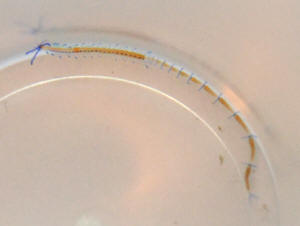
|
|
Hitchhiking Aeolid? Help ID Please... 9/23/11
Ahoy There! Alex again... I'll try to keep this one less verbose than the
past few...
<Verbosity never an issue>
As Bob suggested, I added a truly deep DSB to my sump when I rebuilt it
and have been having virtually no problems since... My nitrates dropped
from 80-100+ to down below 20ppm in about a week (the 50gal water change
undoubtedly helped but after resting and testing I was shocked at how
much difference the new sump makes) and my phosphates are below 0.5ppm
(decreased by a full order of magnitude!), so that's all good.
<Ah yes>
As promised, I will send pictures soon; I just want to let it grow in a
little and then I'll write an article for the WWM forum. I learned a lot
building my own and I am excited to share.
Anyway, while you're thinking about that, think about this (hehheh): I
recently discovered a stowaway in my tank! I know, this is all too
common on the high (maintenance) seas, but I can't figure out what this
guy is. I can tell it is definitely some kind of Nudibranch, probably an
Aeolid but for all I know it could just as easily be from the Glaucidae
family, and by my guess it is still a juvenile.
<Does appear to be an Aeolid>
It has somewhere around 4-6 pairs of brownish-orange cerata and a
milky-white-to-almost-transparent body, and it looks to be just over
0.25" long (not quite a centimeter). I do not have a submersible camera
but after many (literally hundreds) attempts I was able to deftly snap a
few halfway-decent shots through a magnifying glass and then zoom in on
the computer, which is why these chosen few images are still pretty
grainy. I wish I could offer better ones. In these pictures, the big
fork that looks like rhinophores is actually (I think) a large pair or
cerata, and the two pairs of tiny whitish prongs at the anterior end are
what I understand to be the rhinophores and oral tentacles (but these
are nearly invisible in all but the top-leftmost image).
I am curious not only because it looks so much like an adolescent
*Aeolidiella stephanieae*, but because if it's not then I'm concerned
it's probably eating the Zoanthid polyp it's been hanging out on for the
past two days (shown in the pictures).
<Likely so>
If it is a Berghia-type Nudi,
<Not likely>
then it's a bit ironic since I was considering trying to find some but I
chose peppermint shrimp instead (which, by the way, decimated the
Aiptasia in my tank in about 4 days... now if they can just survive long
enough to clean up the tiny ones that will inevitably sprout soon
after...), but I'd also like to know so that I can make a decision one
way or another as to whether I should leave the little guy in the tank
or give it to one of my FOWLR friends who actually has some Aiptasia for
it to eat.
<Maybe the latter, but I would definitely at least remove from here>
I am dubious that it is actually a Berghia though, because not only does
it not seem to have a clear activity cycle (it slowly paces around this
particular clump of Zoanthids night and day), but also because I feel
like there would probably have been more than one with whatever rock
this one came in on. I do not know how small juvenile Hermissenda
crassida specimens can be... perhaps I have one that is recently past
the veliger stage?
<Doubtful to the extreme in captivity... the water moving pumps,
mechanical filtration, lack of foodstuffs of use...>
Zoanthids are in that weird Cnidarian nether-region between a hydroid and
a coral,
<Mmm, much more toward the latter/Anthozoans>
so it wouldn't surprise me to learn that H. crassida might be eating them,
but I also can't tell with certainty that the polyp is being eaten.
These Zoanthids are sensitive enough that I find it equally possible
they would just close up because they're being crawled on, and I can't
distinguish any areas with visible damage. Unfortunately, I don't know
the exact species of these Zoas, so I can't offer much in the way of
spotlighting diet preferences to help identify this hitchhiker... I hope
this image is small enough to accept. I was trying to retain sufficient
detail in the shots.
As always, your scholarly wisdom is highly valued and graciously accepted.
Oh great gurus, what should I do?
<When in doubt I vac it out; it's a free-for-all! Bob (not Ted) Nugent>
PLAH!
Alex:D
|
|
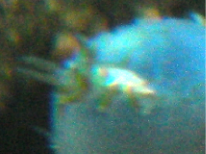
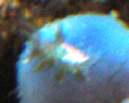
|
Hitchhiking Aeolid? Help ID Please (amendment) 9/23/11
Sorry to send multiple messages, but I just realized a grievous error in
my last note:
I mentioned that possibly my stowaway is a juvenile Hermissenda
crassicornis
because I had found a picture of a baby one (possibly misidentified, now
that I've looked around more...) that looks very similar to the tiny
thing crawling on my Zoanthids. Obviously (to you maybe) that is
impossible or at least very unlikely, because H. crassicornis comes from
cooler waters than my tropical tank and so is unlikely to have survived
long on any rocks from the LFS. But after looking at all the pictures
listed under the Family Aeolidiidae on Bill Rudman's Sea Slug Forum
species list,
<A fave>
I am still not sure what I've got. The closest match besides Aeolidiella
stephanieae might be A. oliviae, with its diet of anemones and maximum
size of ~20mm, but the ones pictured are supposedly 12mm long and they
have many many times the number of cerata I see on the stowaway, and
like the Hermissenda sp. they also seem to be from cooler water.
I will pipette it out of my DT and put it in a jar so I can try to get a
better picture.
Alex
<Thank you. Plah Bob>
|
Hitchhiking Aeolid (Better Pix) 9/24/11
Howdy Bob F. Nugent (good to know the 'F' stands for 'Fletch' haha)
<I wish I had the Chevy Chase income, and much more acting ability!>
So taking good pictures of tiny sea slugs with a marginal camera is
basically impossible, but after much diligence I was able to get
these images. As you can see, the beast has far fewer cerata than
*A. oliviae* and actually does have a faint orange stripe down its
white back, so perhaps it is closer to being a juvenile *Hermissenda*
than I thought (but if that's what it is then supposedly it can get
pretty large). I also noticed that the tips of said cerata are
indeed whitish-colored, and though none of the blacklighted pictures
were worth sending (partly because the camera battery died as I
started attempting them), I was able to clearly see green glowing
specks within the cerata, which confirms that it *was* eating the
Zoanthids (or at least eating their Zooxanthellae). I currently have
the creature isolated in a little plastic magnifier box. I still
have not seen any others in the tank, so I'm not sure how likely it
is this one has reproduced; it is probably a loner. It's too bad I
can't keep it; sure is purdy.
<Can/could... either suffer some attrition of your Zoas, risk
reproduction... or place/keep/feed elsewhere selectively>
Do these shots lend any better clues as to the species, or even
whether I'm dealing with an adult specimen versus a juvenile?
<Not really. Per BillR's excellent SSForum, you'll note that there
is often a very large range of colours/markings, variations in
size/dimensions per species, geographical distribution>
Note the edge of the straight razor placed for size comparison... If
I could confirm that it will survive eating more than just Zoas,
then maybe I could put it in my refugium and let it cruise around in
there.
<Mmm, most Nudibranchs are quite food-specific... Hence my standard
issue of collecting/purchasing ONLY w/ their food organisms>
I doubt it can lay eggs without a partner... Even if it could
there's apparently almost no chance that any young would make it
through the pumps alive.
<Not likely so>
I still don't know which piece of rock/coral it was stashed on, but
at this point it has to have been living in the tank at least a
couple of weeks
<Greatly probable>
because I doubt it was hiding on the lawnmower blenny I bought last
week.
<Highly dubious indeed>
I have examined all the other areas of Zoanthids in the tank and as
yet haven't seen any others, so hopefully I lucked out and only got
one. I guess we'll find out...
PLAH!
Alex:D
PS: Kudos for saying 'PLAH' back... most people are pretty
dismissive of the idea because they don't try to figure out what it
stands for. But I think it's the future of salutation. Now if we can
just make it the future of Foreign Policy as well...
<I do agree. Cheers, BobF>
|
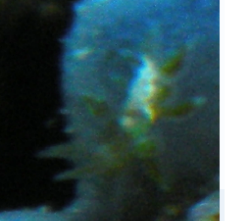 |
|
Re: Hitchhiking Aeolid (Better Pix)
9/24/11
Sorry, I neglected to attach the pictures to that last note...
<Mmm, I just cropped and optimized one of the prev.>
they probably still don't help much though... You guys are troopers.
Thanks for your help.
<Nos vemos. B>
|
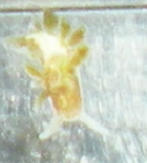 |
|
Watermelon Zoas 9/15/11
Hi WWM,
<Mike>
This whole summer I have been battling with temperature, nitrates, and
rapid salinity changes (due to fan evaporation) and my tank has been
suffering for it. I wanted to find out if there was anything I could do
to help my watermelon Zoas. I have a colony of 100 or so polyps that
over the last three months has wilted and receded dramatically. There
are other Zoas in the tank, some which are doing well and thriving,
<This is likely a good clue... they're winning...>
others are showing the same signs as the watermelons. There did not
appear to be anything visually wrong with the colony, nor any bacterial
infection that I could see with my naked eye, but there was some brown
jelly in the tank earlier this summer that did a lot of damage. The
colony went from having long stalks and long tentacles, to short stalks,
to barely open and now I could see that there is little flesh between
the polyps, some are no longer even connected to the rest of the colony,
and the Zoas look like they are barely open. I was wondering if there is
anything I could do other than a Lugol's iodine dip to try to get them
to recover at this point. I have had no success with this method in the
past, but have not yet attempted to do this with this colony.
They have been shrinking for months now, even when other life is
starting to recover (other Zoas included), and it seems to me that
unless I do something they will not survive. I have made attempts at
moving them to places with less light, then more light, more flow, then
less flow, and noted no impact from the move. There are no other pieces
nearby competing for space either.
Any advice is greatly appreciated.
Thank You,
Mike
<Mmm, what do you feed these colonies? What re water quality test
results?
Please peruse here: http://wetwebmedia.com/ZoHlthF6.htm
and the linked series above. Bob Fenner>
Re: Watermelon Zoas 9/16/11
Hello Bob,
<Mike>
Thank you for the prompt response. Currently my water results show 0
nitrites, nitrates, and ammonia. Salinity is at 1.024, and temperature
is at 80 F. The fluctuations this summer have been high and at worst,
when my tank reached 92 degrees F
<Whoa!>
resulting in a massive crash driving the ammonia up and nitrates to
80PPM. It destroyed over half of the inverts and corals, and damaging
others. Most that survived are still recovering, but some of my Zoa
colonies appear like they are dying slowly.
<Happens>
It is a 110g and there is much space between the Zoa colonies at this
time, and throughout this crash. I attached a before and after image
about 2 - 3 months apart. This was all after the crash. The Zoas started
receding then, at first they gained a lot of color and brightness, but
it seems that it was only due to the fact that they were shrinking. I
have also increased the amount of light in the tank since then, but do
not have a par meter at this time. Moving them to less/more light did
not improve their condition.
<I see>
I use RODI water from a new system I set up about 3 months ago. The
water shows 0 TDS but since I started using it there are some diatom
formations on the sand. Other information I could think of is that
because of the fan blowing directly over the surface of the water, the
salinity fluctuations have been high. As much as +/-.003 over the period
of just a few days. But this has recently stopped due to the cooler
weather. Given the circumstances, is there anything you could recommend?
<Mmm, tests for Ca, Mg and alkalinity... You might want to read on WWM
re the brand of salt mix you're using... Some have had troubles/been
trouble.
BobF>
Regards,
Mike
|
Sick zoos 6/17/11
Hey guys,
I hope you are all doing well. I was wondering if you might be
able to help me with something? I have a 250 gallon reef aquarium
with very good, stable readings.
PH 7.9-8.1
Temp 78-79
Nitrate always less than 1
Po4 0.03
Calcium 410
Magnesium 1250-1300
Alk 7.5-8
Recently, I noticed one of my Zoanthid clusters starting to close
up and turn kinda black...
<I see this>
The zoos have been in there a few months now and I have no idea
what this might be but I am hoping to stop it before it gets
worse.
I have attached a couple of photos of the troubled area. Would
you be able to take a look and offer your opinion? Any advice
would be much appreciated.
Thank you,
Jason
<Mmm, what is immediately above this Zoanthid colony? It
appears that there is some Cyanobacterial growth to the right...
Are any other organisms in this system showing overt signs of
stress? What other stinging-celled life is around this area? What
sort of (solid) supplementation do you do? Is it placed directly
in the tank? Bob Fenner>
|
|
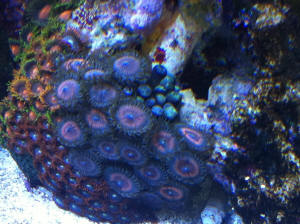
|
Re: Sick zoos -- 06/17/11
Hey Bob,
Thanks for getting back to me. See my answers below...
<Mmm, what is immediately above this Zoanthid
colony?
***Ricordea mushrooms and another colony of zoos... the
other zoos where added two weeks ago, but are easily 3
inches away. The Ric's are about 4inches away
<<Uhh... I see what is almost assuredly the issue in
your system pic you sent along... have cropped the area...
to the upper right there appears to be a healthy Euphylliid
of some species. It is almost doubtless sending out
mesenterial filaments, stinging the Zoanthid>
It appears that there
is some Cyanobacterial growth to the right...
***I am not certain that is Cyano? I have had Cyano before
but it looked a lot "softer" than this stuff.
This red stuff is quite hard. (I am assuming you are
referring to the red stuff on the bit of white pipe behind
the sick Zoos). I feed heavily, but skim aggressively and
my po4 is never over 0.03 (I test weekly with a Hanna
digital tester)... but obviously you would know this better
than I... so maybe it is Cyano.
<Easy to scrape, take a look under a 'scope... or
just feel... is it slimy?>
Are any other organisms in this system showing overt signs
of stress?
***Actually just below the Zoos is a clam that is slowly
recovering from a rough time. It was previously getting too
much light ( at least I think that was the issue),
<I think it too was getting stung>
so I moved it to this location just below the sick
Zoos...
(3 weeks ago maybe?). I also have an SPS on the other side
of the tank that browned out last week (I got too close to
him with Joes Juice trying to get Aiptasia I think). I have
stopped using this and bought some peppermint shrimp. I
should note that I only used Joes Juice in that one spot on
the other side of the tank.
What other stinging-celled life is around this area?
***I have torch coral that is probably within 4 inches.
<<Ahh! This is IT>
It actually has grown into another colony of Zoos, and they
seem to not bother each other too much. Is it possible a
torch would touch one group of Zoos and have little effect,
and then sting another group of zoos that is inches away
and do so much damage?
<Yes, assuredly>
I never actually considered this... I have attached a tank
shot so you can get an idea of the spacing.
What sort of (solid) supplementation do you do?
***The only regular form of supplementation I use is a
calcium reactor. In the last month my co2 controller
stopped working for a few days and I had to use reef
builder to get the ALK back up, but that was it. It was
added to the sump over a few days and has since
stabilized...
<S/b fine>
Is it placed directly in the tank?
*** No.
Bob Fenner>
Thanks for your time Bob.
<Welcome Jas... I know it's a pain, but I'd be
moving either the torch (with at least six inches, better a
foot) or Zoanthid colony apart. BobF>
|
|
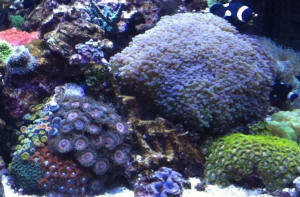
|
Re: Sick zoos
Thanks so much Bob. I'll adjust accordingly. If I could
please ask just one follow up question? To the right of the
torch coral, you see all the green Zoos that have grown
directly into the Torch coral? They seem totally
unaffected.
<Yes and yes>
So my question is, what makes this type of Zoos so tolerant,
and the sick Zoos being so affected and showing so much
stress after all this time? (almost overnight).
<Mmm, don't know, but I'll speculate that there is
some sort of chemical communication and accommodation that
occurs... but on what basis?>
The reason I ask is that I really like how the two have grown
into each other, but of course I don't want to have stuff
dying...
Thanks again
<Do try our new search tool (thanks Darrel) with this
string: +Zoanthid and +Euphyllia compatibility
Here: http://wetwebmedia.com/Googlesearch.htm
Read the cached views. Bob Fenner>
Re: Sick zoos -- 06/17/11
Will do. Thanks Bob
<Welcome. B> |
|
|
Rotting Zoas... BGA, env. 3/31/11
Hello
I am having a problem with one of my Zoa colonies. Over the
weekend a red algae
(it almost looking like red spikes)
<Likely BGA... and the conditions that allow/ed it. Prominent
in your photo.>
started growing on one of my Zoa colonies.
Over the next few days the polyps began to close and the red
algae began to grow. As the algae spread polyps began to rot and
flake off. Today I fragged what was left of the
"healthy" colony and it seems to be fine for now. I
really don't know what this is. My Parameters seem to be fine
Ammonia 0 Nitrites 0 Nitrates 10 Alkalinity 9dkh Calcium 400. I
am running a protein skimmer as well as Chaeto. I use R/O water
with a 0 TDS rating. No new additions or change to equipment. The
red (spikes) in the picture are towards the front of the rock as
well as growing on the back.
Anything you could tell me would be much appreciated
Thanks
<Your water quality is "the reason" here... But do
start by reading:
http://wetwebmedia.com/bluegralgae.htm
You need to fix the environment to not suit the Cyanobacteria.
Bob Fenner>
|
|
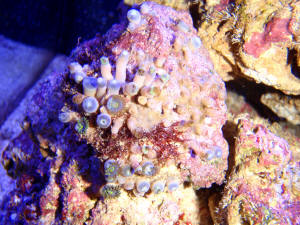
|
|
Is there a Zoa/Coral Expert in the House?/Zoanthid
Hlth., Compatibility 3/17/2011
<Hello Victor>
I suspect there is someone with extensive experience and
knowledge of Zoanthid diseases and pests who can help me... and I
need help! I have what appears to be some sort of fungal or
bacterial ailment affecting several species of Zoanthids in my
tank. I've done everything I can to iron out the well-known,
well-documented diseases and pests. So far I have zero signs of
spiders, Zoa pox (large distinct raised white spots), Nudibranchs
after months of looking for them.
The behavior I have seen has spread between colonies, usually
adjacent (but not always). Some Zoas across the tank or even on
the same rock are open and happy, while others are miserable and
haven't opened in weeks or have shrunk to be almost
invisible. It is almost always the same set of symptoms.
These are:
- Bulging center disc/mouth
- Discoloration/matte/yellowish coloration
- Shrinking in size over time (some of mine have shrunk from
normal size to just a few millimeters wide and are very
pale/colorless, but have survived in that state for many
months)
- Staying closed most of the time, rarely opening
- Recently I have also seen a couple of odd things, such as some
filamentous-looking material (fuzz-like, but not cotton-like) on
some ailing polyps
- Odd, long red strands, do not appear to be algae, coming off
of/growing around Zoas, and even coming out of the mouth a couple
times - Infrequently on affected Zoas (noticeable when closed)
what almost looks like the Zoas skin sloughing off in a few
places, flapping in the current
My tank has been up and running for about a year and a half. I
take the stewardship of the tank very seriously and all my water
chemistry is stable and within range, with 15% PWC weekly. These
are not being stung by anything that I know of. I've ruled
out every commonly identified ailment and am at a loss here.
If it is something that can be fought back with dips, what would
you suggest? These Zoas are all attached firmly to and grown all
over a medium sized rock so I would have to remove the entire
piece from the tank and (ensuring that there are no snails or
other critters hiding inside) dip the whole thing at once in
matched pH/temp freshwater, possibly with iodine.
Would this help? Would it kill off enough animals in the rockwork
to spike ammonia or otherwise cause issue in the tank? If I do
dip the whole rock, is iodine a bad idea (since it will likely
get stuck in the rock and brought into the tank? If it looks like
a bacterial issue, shall I try dipping with Furazolidone?
I know that's a lot of information and I probably sound like
an aquarium hypochondriac, but this is extremely frustrating and
I don't want the animals to suffer. Attached are a few photos
that sort of illustrate what I'm seeing.
<Victor, please provide us a list of other corals you have in
this system.
I have a strong feeling that allelopathy may be playing a role
here. James (Salty Dog)>
|
|
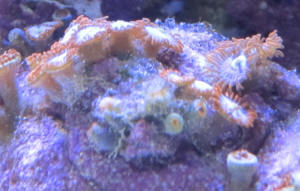 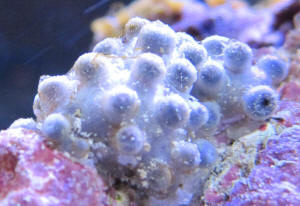
|
|
Re Is there a Zoa/Coral Expert in the House?/Zoanthid
Compatibility 3/17/2011 - 3/18/2011
Hi James, thanks for the reply.
<You're welcome.>
The other corals in the tank include...
Zoanthus sp (Various)
Cyphastrea japonica
Cyphastrea occelina
Seriatopora guttatus
Seriatopora hystrix
Pocillopora sp (green)
Pocillopora sp (pink)
Acropora sp (green, wild)
Acropora millepora "Palmer's"
Acropora sp "Lokani 20k"
Acropora sp (blue Staghorn)
Acropora sp (red planet)
Montipora capricornis (red)
Montipora capricornis (green, purple edges)
Montipora palawanensis (apple berry)
Montipora danae (Sunset)
Montipora danae (Superman)
Favia sp (Christmas)
Dendrophyllia sp
Clavularia sp (Papaya)
Clavularia sp (tiny purplish cloves)
Clavularia viridis
Sarcophyton ehrenbergi (neon green toadstool)
Duncanopsammia axifuga
Acanthastrea sp (two types)
Lobophyllia sp
Ricordea florida
Actinodiscus sp "superman"
Euphyllia divisa
<Likely your worst customer here. Euphyllias can form long and
very powerful sweeper tentacles and very few corals survive an
attack by members of this genus.>
Blastomussa merleti
(Boy that's a lot now that I had to list them out)
<Is quite a few.>
Honestly I would rule out allelopathic causes. The reasoning is
that I'm using a small amount of carbon,
<Carbon is not a complete cure all for allelopathy. I know of
a couple of instances where aquarists who use Chemipure on a
regular basis and have introduced Mushroom Anemones into their
system which eventually wiped out their entire Zoanthid colonies
and Torch Corals within a matter of weeks.
Coral compatibility is just as important as compatibility among
fish.>
and the Sarcophyton is only the size of a quarter. Furthermore it
has been in the tank for over a year and this is a more recent
development. The Actinodiscus specimen is new, the size of a
dime, and all of these issues predate the introduction of it into
the tank.
<Like most Corallimorphs, the Actinodiscus have developed
effective chemical defense systems and can cause significant
passive destruction to nearby corals. Most corals will not be
able to settle in/live near these corals regardless of their
size.>
A bit more information that may or may not help. I've
experienced a recent Bryozoan bloom in the nooks and crannies of
my rock work; small root-like organisms that seem to be
flourishing. But more significant than that is an apparent mat of
fungus, bacteria, chrysophytes, or a saprophytic alga.
It's a thin translucent colorless fuzzy film over much of the
rockwork that does not look anything like green hair algae, red
slime, etc, and is also found on and around the affected polyps
(but not on any of my other corals). I am very confused!
<I suggest reading here and related files found in the
headers.
http://www.wetwebmedia.com/corldisart.html
http://www.wetwebmedia.com/zoanthidcompfaqs.htm
I'd also like to suggest getting yourself a copy of Aquarium
Corals by Eric Borneman, likely one of the best references on
coral care, health, and disease that I have come across.>
I forgot one coral, an Acropora yongei (green slimer).
In the pictures from my first email you can see the
aforementioned film/fuzz in a few places, but I didn't
photograph it specifically. I'll see if I can get some shots
tonight.
<Won't be necessary. Since you mention nothing of your
tank size, lighting, filtration methods, etc,
I will assume you are using an efficient protein skimmer which
can help reduce allelopathic compounds
along with using more than "a small amount" of carbon
and/or chemical media such as Chemipure.
I also suggest dosing iodine/dide. I feel much of your problem is
a combination of stress related necrosis and allelopathy. Do
concentrate on improving water quality, good test results are not
necessarily indicative of good water quality. I will ask Bob for
his input here as well. James (Salty Dog)><<Nada
mas>>
|
|
Worm ID: Syllid within Palythoa Colony --
3/9/11
Hey WWM Crew,
<Hey Todd, Lynn here today.>
I found this little critter on my Palythoas and was wondering if
you knew what this worm is?
<Yep, it's a type of Syllid, most likely in the genus
Myrianida, that's in a reproductive phase. Syllids are
generally fairly small worms (couple of cm/<1'), that tend
to live either in the upper layers of the sandbed or above it,
where they're associated with everything from sponges to
corals, tunicates, hydroids, bryozoans, etc. It's a very
diverse group of worms.>
I am not sure if it was eating my Palythoas, but it was for sure
irritating them.
<I bet so. The last time I ran across one of these guys, it
was associated with Palythoas and was indeed either consuming, or
at the very least irritating them. I would remove this, and any
others that appear within the colony. For more information,
please see the FAQ titled 'Saltwater Polychaete ID Question:
Syllid Stolonization -- 1/19/09' at the following link (as
well as link supplied within): http://www.wetwebmedia.com/PolychaeteIDF7.htm?h=
>
My best guess would be that it is in the Class: Polychaeta, but I
am not positive.
<Right you are. It's a Polychaete in the family
Syllidae.>
Any insight would be greatly appreciated.
Thanks,
<You're very welcome.>
Todd
<Take care, Lynn Z>
|
|
 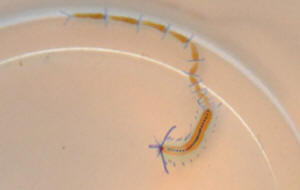
|
|
|

